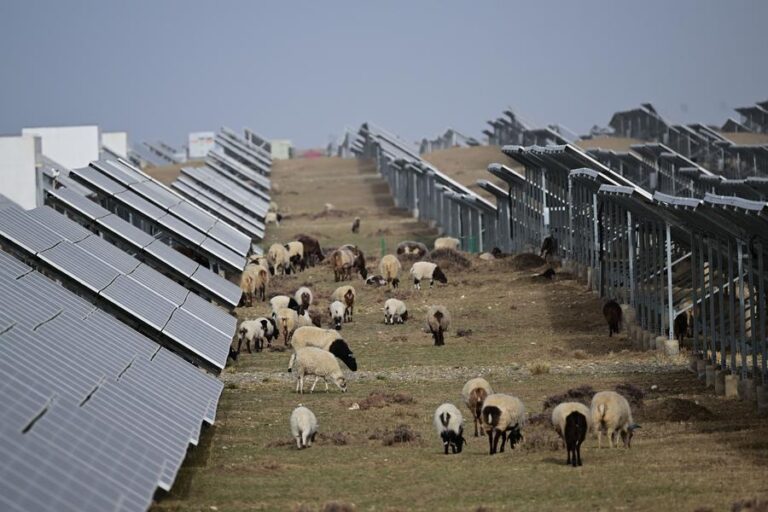XINING, Oct. 22 (Xinhua) — For generations, the Talatan Gobi Desert in northwest China’s Qinghai Province has endured severe sandstorms, persistent droughts and sparse vegetation, making life for local herders a constant struggle against a harsh natural environment.
Today, Talatan, located in Gonghe County in the Hainan Tibetan Autonomous Prefecture, is undergoing a remarkable transformation. Expansive arrays of deep blue solar panels now stretch across the plateau, harnessing abundant sunlight to generate clean energy. Beneath their shade, pasture grass flourishes, and sheep graze and play freely in what is emerging as a vibrant new savanna.
Yehdor, a local 49-year-old herder, has witnessed this change firsthand. He now tends his flock while riding a motorcycle.
“Our village depends mainly on animal husbandry, and many families raise sheep. In the past, the grassland wasn’t productive enough, so herders had to take their sheep far away to find grazing land,” Yehdor recalled.
Decades of drought and overgrazing had turned Talatan into a near-endless desert. The turnaround began in 2012. Leveraging the region’s strong solar resources and vast flat terrain, the local government promoted the construction of a solar energy base. Today, a sprawling photovoltaic park covers more than 300 square kilometers and is operated by over 60 solar companies, making it one of China’s major gigawatt-level solar hubs.
Unexpectedly, the dense solar arrays also act as barriers against wind and sand. Their shade creates a cooler microclimate and reduces evaporation, while periodic cleaning by maintenance crews allows runoff water to seep into the soil, further nourishing the land below. This environment has proven ideal for grass growth. As vegetation returns, soil moisture has improved to the point where grass sometimes grows so tall that it almost seems to reclaim the desert.
“In some areas, the grass grew over a meter high, even blocking the solar panels and reducing power efficiency,” said Cao Jun, a staff member with the project department of the local industrial park.
Faced with this challenge, the solar companies turned to local herders. An agreement was reached allowing herders to graze their sheep beneath the panels, providing a natural solution that avoided costly manual or chemical methods. In harder-to-reach areas, herders also harvest grass to use as winter fodder.
“It is a win-win solution. Herders earn extra income while companies save on weeding costs,” Cao said.
Technicians also adjusted the panel layout, widening the spacing between arrays from three to five meters and raising the mounting height from 50 centimeters to between 1.5 and 1.8 meters, allowing sheep to move freely beneath them.
Once all projects in Hainan prefecture’s 609-square-kilometer photovoltaic park are completed, the grass-planted area is expected to reach 450 square kilometers, yielding around 110,000 tonnes of grass annually. The energy base also provides employment opportunities for local residents.
Technology is enhancing both pasture and livestock management. Some photovoltaic stations employ infrared drones and monitoring systems to track herds across the vast area. In addition, certain pastures equip sheep with digital ID cards in the form of QR code ear tags, storing information such as age, vaccination history and owner details for traceable management.
Each year from June to October, herders can graze sheep in the photovoltaic park free of charge. Under these agreements, nearly 100,000 mu, or roughly 66 square kilometers, of company-owned pastureland is now accessible to local herders.
The prefecture has established 32 photovoltaic eco-pastures and 56 centralized grazing sites within the solar park, supporting 18 surrounding villages that raise more than 20,000 sheep each year. As sheep raised under the solar panels gain recognition, locals have developed a brand for “photovoltaic sheep” and now sell mutton nationwide through e-commerce platforms.
“Our family earns nearly 100,000 yuan (about 14,000 U.S. dollars) a year from raising sheep,” Yehdor said. “My flock has grown from 200 to over 300, and our sheep are healthy and strong. Life is much better.”
The model combining photovoltaic power generation and animal husbandry, pioneered in Talatan, offers a new approach to desertification control and clean energy development.
In Xinjiang Uygur Autonomous Region and Gansu Province, similar initiatives harness solar power to improve the microclimate, supporting agriculture while combating desertification in arid regions. In Yunnan Province and Inner Mongolia Autonomous Region, high-value traditional Chinese medicinal herbs such as licorice and astragalus are planted beneath solar panels, providing an additional source of income for local farmers.
As China advances green energy, an increasing number of industries and applications are being creatively integrated with it, enabling more efficient use of resources and generating greater overall benefits, while transforming once-barren lands into greener, more prosperous landscapes. ■

